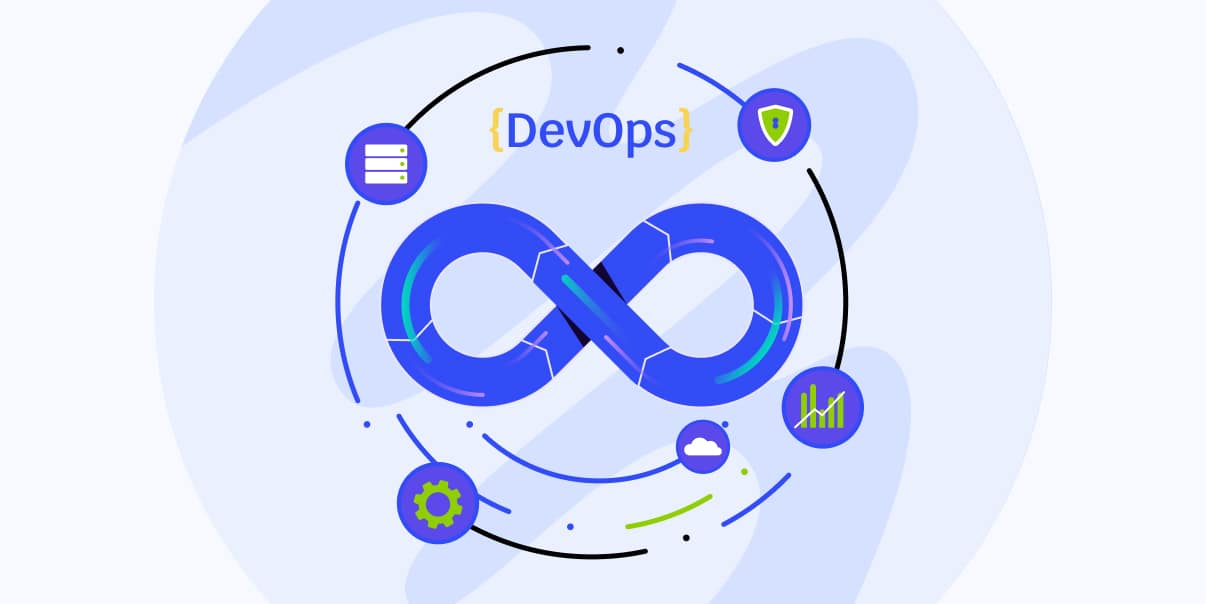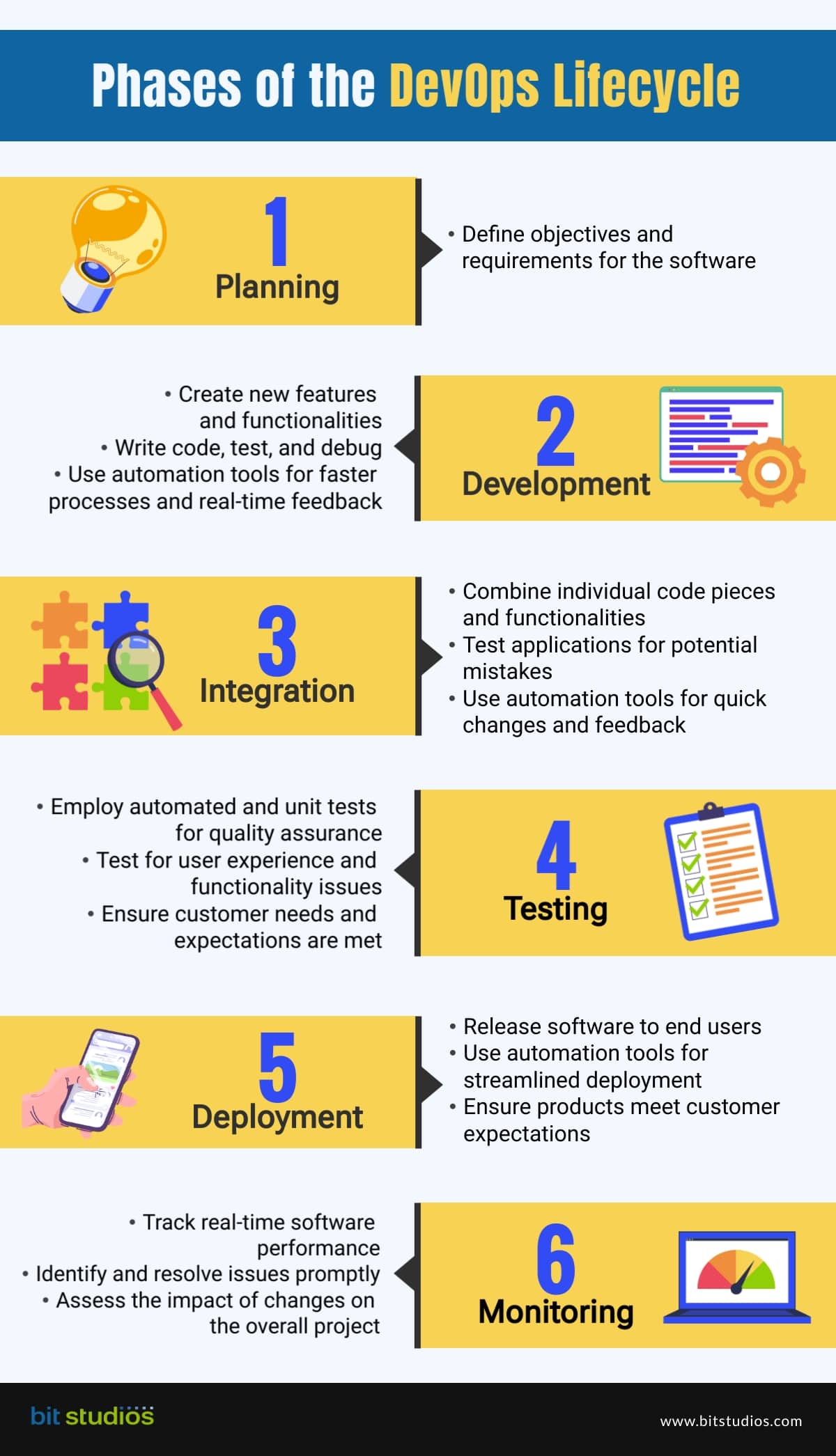What Is DevOps? Learn the Fundamentals of DevOps

DevOps is a way for organizations to develop software faster by introducing new processes and practices. It includes automation, collaboration, monitoring, testing, and deployment. It also improves communication between departments. This way, they can deploy their products faster and maintain quality standards.
But what is DevOps, and how can it benefit your business?
DevOps is a way to help your organization build software better and faster. This article will explore how DevOps works and how it will benefit your team.
Definition and History of DevOps
DevOps combines the efforts of developers and operations teams. It creates a collaborative environment for faster and more efficient delivery. Moreover, it focuses on creating continuous integration between development and operations teams. It helps in shortening the time it takes to deliver applications or services.
But how did companies start using the principles of DevOps?
Patrick Debois and Andrew Clay Shafer coined the term DevOps in 2009. It was when they started the Agile Operations Community of Practice. Their group worked to optimize how operations and development teams work together. Their goal was to make software delivery faster and more efficient through a new practice. Today, the DevOps movement has grown, and many companies are using it.
DevOps is transforming traditional operations by breaking down the walls between teams. As the operations and development teams work together, they learn more skills. Now, they can work seamlessly from software creation to implementation with fewer errors. This method ensures everyone is on the same page in the application’s lifecycle.
Some DevOps models include extra steps to make the process better. These steps include making sure their products are secure, or what we know as DevSecOps.
Moreover, DevOps create an agile environment for faster deployment and fewer iterations. The team automates its processes and uses a technology stack to operate apps. They also have tools that help developers do tasks without other groups’ help.
DevOps vs. Traditional Operations
DevOps is a new way of doing things in software development. It helps to make product development better than before. In a traditional operations environment, operators and developers work separately. This new process brings teams together so they can work more effectively.
Here are some of the comparisons of DevOps to traditional operations:
Efficiency
In a traditional production environment, operators and developers work by themselves. This separation often creates inefficiency and delays in the product development process. Development teams have to wait for feedback before they can continue. It can often be slow and take time to complete.
Additionally, silos prevent collaboration between teams and hinder communication. As a result, the product delivery process can be inefficient and slow.
But DevOps makes things more efficient by making it easier for different project teams to work together. It joins the development and operations team into one group. This step makes it easier to improve the software delivery process. Also, this process allows developers to talk to operational staff more quickly and effectively.
With DevOps, developers can ensure quality assurance without waiting for feedback from others.
Schedule Management
DevOps is a way to manage schedules more efficiently. Operators and developers work together so they can finish projects faster. This approach provides more visibility into the progress of a project. It also allows developers to adjust their timelines better.
With its continuous integration, DevOps requires less manual testing and debugging time. It saves time for feedback or making code changes. As a result, development cycles are shorter, with fewer errors and improved accuracy.
Moreover, there are automation tools that can help further speed up processes. They automate tedious tasks such as configuration management and log analysis.
DevOps helps organizations manage their schedules better with a shorter development lifecycle. The process also improves transparency on progress and utilizes automation tools. It also leads to a smoother experience when meeting deadlines.
Culture
Traditional development often causes problems between the development team and the operations team. It is challenging for the two teams to work together and meet customer demands. In some cases, the development team feels excluded from what’s happening on the operational side. It causes communication problems and slows down production cycles.
But DevOps makes working together possible for operators and developers. It helps them communicate better so they can deliver software more efficiently. This approach also encourages team members to keep learning from each other. With this mindset, developers can more easily learn new skills and technologies.
Moreover, team members must be open to new ideas when working with a DevOps culture. They should be willing to try new things and learn from their mistakes. This culture encourages employees to take risks and experiment with different approaches. It also eliminates silos so teams can work together more effectively.
Metrics
DevOps and traditional operations have different processes for tracking success.
Traditional software development practices usually rely on a more reactive measurement. It means they only know what their development team is doing once it reaches production. Then, they track issues reported by customers. These include bugs or other problems that can hinder customer experience. After addressing issues, they measure the troubleshooting time.
But, DevOps teams use a variety of metrics to measure success. These include:
- Lead time. This metric is the time it takes developers to commit codes when they deploy it to production.
- Mean time to recovery. It refers to the average time the system recovers after an incident.
- Continuous integration cycle times. It refers to how long code changes take to integrate into the main branches.
Additionally, DevOps teams track key performance indicators (KPIs). It helps them understand how well their systems are performing. Some examples of KPIs are uptime and latency.
DevOps practices track what’s happening during each product development stage. It helps them avoid issues by quickly identifying problems before they reach production. It also creates a better plan by anticipating the improvements a product needs.
Benefits DevOps
DevOps introduces new methods and practices to improve department collaboration. To understand DevOps further, let’s take a closer look at its benefits.
Improved Communication Between Teams
The essential part of DevOps is how well the development team works with the operations team. Some companies ensure that the DevOps team works with the security teams. By introducing better communication methods, organizations can reduce delays in product releases. It’s also easier to optimize their software delivery process.
Reduced Deployment Times
The DevOps approach prioritizes automation. This step allows developers to deploy software faster with fewer manual processes. Automation enables teams to make changes quickly. They can also receive feedback on their progress in real-time.
Moreover, DevOps reduces the time for the deployment of applications or services. Still, it maintains quality standards despite the fast process.
Enhanced Security and Compliance
DevOps teams use continuous integration tools to ensure quality and security standards. It allows them to detect errors and change the organization’s compliance protocols. Moreover, DevOps teams can roll out updates more often. They also don’t have to compromise security or performance.
Increased Efficiency
DevOps helps software developers achieve their goals faster through automation and better communication. This process makes it easier to deploy software updates and saves time and resources. Also, it shortens the time developers need to deploy a product. It makes optimizing their operations more convenient with fewer resources.
Less to No Manual Errors
Finally, DevOps reduces manual errors in software development through automation. Errors can occur when teams deploy products or services manually. But automating the process can prevent this. It allows organizations to deliver software faster with fewer risks.
Better Quality Control
Through continuous integration, DevOps teams can ensure their software meets quality standards. It allows them to review and test changes before deployment. This step helps maintain product reliability.
Key DevOps Principles
You must understand the principles of DevOps before implementing it. It will help you create changes in your organization better. To become successful in DevOps, teams need to apply these practices. They also have to check how it affects their workflow.
Automation
Automation is essential in DevOps to streamline processes. It also reduces manual steps that can lead to errors. Automating tasks such as deployments and tests allows you to deploy software faster. It also minimizes the risks of your product.
Collaboration
Collaboration is the foundation of DevOps. It focuses on bringing development and operations teams together to ensure their success. By introducing a better software development practice, organizations can reduce delays. DevOps is also a great way to optimize software development cycles.
Continuous Improvement
DevOps encourages teams to track their processes continuously. They also need to improve their implementations. DevOps teams can optimize their operations by applying feedback. This way, they can create a better customer experience. Developers can also experience faster deployments with fewer errors through it.
Customer Centric Decision-Making
DevOps puts the customer first. It focuses on understanding what customers need and expectations of the product. It helps organizations know what areas to focus on. They can also improve their software to meet customer requirements faster.
Create With the End in Mind
DevOps teams must create and deploy software with the customer in mind. It means they must focus on what customers want and how they will use it. By doing this, organizations can ensure the quality of their software.
How To Adopt a DevOps Model
To use DevOps, you need to know what it is. This way, you can ensure that what you deliver meets customer requirements. It also deploys the product right away and with fewer errors.
DevOps involves operators and developers working together. Their goal is to make things faster and better through better collaboration. Here, teams use automation to ensure the software is of good quality.
By following the principles of DevOps, you can ensure better communication between teams. You can also improve deployment times and enhance security.
Organizations must improve their software development process when adopting a DevOps model. You should also provide the right tools to achieve efficient operations. You must ensure that everyone on your team understands its essence and benefits.
Phases of the DevOps Lifecycle

The DevOps lifecycle comprises five main phases: Develop, Integrate, Test, Deploy, and Monitor. Let’s look at what each step entails.
Development
The first stage of the DevOps lifecycle is development. Here, developers create new features and functionalities for the software or service. Developers write code, test it, and ensure everything works well. Their tasks also include debugging any errors during testing. They use automation tools to help speed up processes. This way, developers can make changes right away. These tools are also beneficial when receiving feedback on their progress in real-time.
Integration
The next step is integration. The team must check if the software the developers created meets the market standard. During this phase, teams can also test their application. It can help you find potential mistakes before making them available to the public. Automation tools speed up the process of making changes and receiving feedback.
Testing
Teams can use automated and unit tests in the testing phase to ensure they deliver excellent software. You can also test what they create to detect user experience or functionality issues. It helps them make sure what they provide meets what their customers need and expect.
Deployment
The fourth phase is continuous deployment. This step focuses on releasing what teams create to the end user. During this phase, you can use automation tools to streamline what you need to release. It also ensures that the software product meets customer expectations. It helps teams deliver quick and accurate products and services.
Monitoring
In the monitoring phase, teams ensure that their release is working well. They use tools to watch what is happening in real-time to see any problems and fix them immediately. This step keeps everything running smoothly. It also lets teams know how their work affects the entire project.
DevOps vs. Agile Methodology
When discussing DevOps, you must understand what sets it apart from others. One of the closest methods to it is Agile, which confuses many people. But there are some differences between the two.
Agile development focuses on delivering premium software faster with continuous feedback. We also have an article that discusses this process more.
Meanwhile, DevOps allows the development and operations teams to work together in one environment. It helps organizations improve what they deliver. It also makes their software development process better.
DevOps is a working method that automates tasks and monitors progress. It also allows you to integrate new code continuously. It relies heavily on good communication between team members. This way, you can ensure that the product meets customer expectations.
Top DevOps Tools To Try
It would be best if you used the right tools to have a successful DevOps model. Here are the best DevOps tools you can use for your organization:
Puppet
Puppet helps organizations automate deployments, tests, and monitoring tasks. It simplifies what teams need to do to maintain their systems and infrastructure.
Key Features: Software delivery process automation and real-time monitoring
Price: A free version and paid plans that start at $69.99 per month
GitHub
GitHub is a popular version control platform. It allows teams to collaborate on code in one centralized place. It also lets developers track what they create and what they need to release.
Key Features: Tracks changes, simplified collaboration, version history, continuous delivery
Price: Free or paid options that start at $44 per month
Ansible
Ansible is another automated configuration management tool used by many organizations worldwide. It also helps simplify what teams need to do to deploy applications or services. This tool makes it easier to maintain what they create.
Key features: Software delivery process automation, real-time monitoring, simplified collaboration, version history tracking
Price: A free trial and paid plans starting at $39 per month
Jenkins
Jenkins is an automation server that helps teams work in an automated environment. It allows organizations to reduce their manual labor. It also helps them streamline their tasks.
Key Features: Task automation, testing record tracking, real-time feedback on progress, continuous delivery
Price: Free and open-source
Chef
Chef is an automation platform that simplifies configurations and maintenance of infrastructures. It helps organizations reduce and streamline their manual tasks. With Chef, teams can easily set up a comprehensive automated pipeline. It allows them to deploy what they create reliably, consistently, and safely.
Key features: Infrastructure configuration management, workflow automation, real-time monitoring, and version history tracking
Price: A free, open-source version and paid enterprise options that starts at $250.00 per year
Kubernetes
Kubernetes is an open-source container orchestration platform used by many software developers. It helps organizations manage what they deploy. It also ensures that their app or services have what they need to run.
Key Features: Task automation, simplified collaboration, better security and compliance, continuous delivery
Price: Free trial and paid plans (to be requested)
Docker
Docker is a popular containerization platform. It simplifies what teams need to do to package and deploy what they create. It offers automated environments for development, testing, and production stages.
Key Features: Task automation, simplified collaboration, version control tracking, and infrastructure configuration management
Price: A free trial and paid plans that start at $7 per month
Microsoft Azure DevOps
Microsoft Azure DevOps helps developers and operations teams work together. It helps them make sure what they create is of good quality. It also has features like continuous integration. This feature lets teams make changes and get feedback immediately.
Key Features: Continuous integration, version control tracking, infrastructure configuration management, workflow automation
Price: A free, open-source version and enterprise options that start at $2 monthly per user
Conclusion
DevOps is a way of developing software that focuses on team collaboration. It’s essential to understand the benefits of DevOps in improving your process. Automation, collaboration, and continuous improvement are all critical aspects of DevOps. When used correctly, these can revolutionize your operations.
Are you planning to leverage the benefits of DevOps in your business? BIT Studios team can assist you in attaining success and efficiency through DevOps. Contact us today for DevOps consulting services.
DevOps FAQs
Does DevOps Need Coding?
No, DevOps doesn’t need coding. It’s a combination of development and operations teams working together. Their main goal is to improve what they deliver to customers faster with fewer errors. DevOps teams use automation tools like continuous integration to ensure software quality.
To sum it up, coding knowledge is beneficial in DevOps. However, it’s optional to use this approach.
How Can I Find a Reliable DevOps Engineer?
If you’re planning to hire in-house DevOps engineers, consider employee referrals. But if you want to outsource your projects, you can partner with reliable companies. It provides you with better security and better product qualities.
If you need help, BIT Studios is here for you. We have a team of experienced DevOps specialists to optimize your software development.
What Skills Does DevOps Require?
When looking for a reliable DevOps engineer, consider the following qualities:
- Knowledge and experience in programming languages like Python, Ruby, and Java
- An understanding of automation tools
- Expertise in continuous integration (CI) tools
- Familiarity with cloud platforms like AWS, GCP, or Azure
- A deep understanding of DevOps principles and software development lifecycle
Additionally, communication is vital when working with development and operations teams. So, looking for engineers with excellent interpersonal and collaboration skills is ideal. Finally, check their background for any past projects related to DevOps. It will show their ability to deliver successful results.
We’re BIT Studios!
At BIT Studios we specialize in designing, building, shipping, and scaling beautiful, usable products with blazing-fast efficiency



